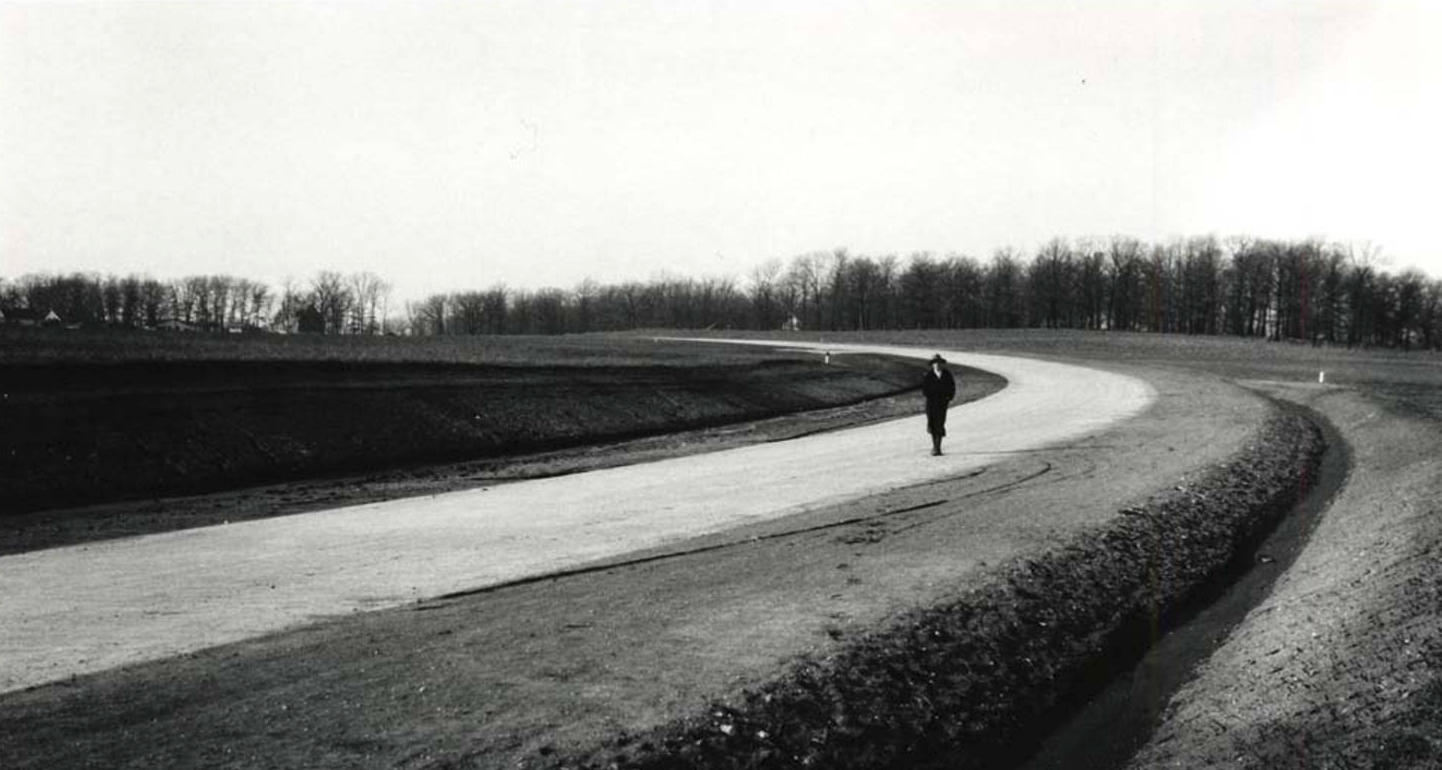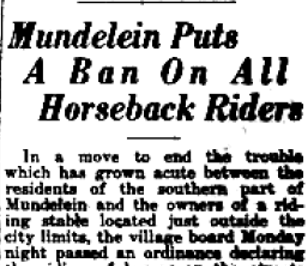The residents of Libertyville and Mundelein witnessed rapid change during the late 19th and early 20th centuries, from the installation of Libertyville’s first electric lights in June 1897 to Mundelein’s first telephone in the early 1900’s. Few changes, however, had quite the impact than the transition from horse-drawn carriages to our new ubiquitous cars. So let me take you back to a time not so long ago, when hitching posts still dotted the streets while horses and cars, often in competition with each other, shared the road.
At the end of the 19th century, both villages were much more rural and in the absence of motorized vehicles, horses were used for pulling plows, powering machinery in mills and factories, and, if you didn’t want to walk, transportation. According to the June 1880 non-population census, Mundelein and Libertyville, along with the many farms that surrounded them, were home to some 263 and 650 horses respectively. Those horses, in turn, supported a number of businesses in both villages. Walking down Milwaukee Avenue in the late 19th century, at the time still a dust or mud-covered road depending on the weather, visitors to Libertyville would have first passed by Charles H. Kaiser Harness Shop. Located on what today is the Libertyville Bank & Trust, Kaiser also sold horse blankets and in advertisements boasted that he “always had Baum’s horse & stock food on hand.”7 Going further north up Milwaukee Avenue was the O.I. Luce & Co. Harness Shop, William T. Lake wagon making and repair shop, as well as a number of blacksmiths, including Henry Morman and Charles Schwebs.

Neighboring Mundelein had its own businesses dedicated to the upkeep and maintenance of the village’s horses, including Harden’s Hotel & Livery and Central Hotel & Livery. Located on the corner of W. Maple Avenue and N. Lake Street, Harden’s Hotel & Livery opened in 1896, providing “superior accommodations” as well as a “well equipped livery.”6 Located nearby on 534 N Seymour Ave. was the Central Hotel & Livery. Built in 1886, making it one of the oldest still standing buildings in Lake County, the hotel’s then-owner Fred Knigge built a barn behind his establishment in April 1903. Both hotels catered to local laborers or itinerant salesmen who arrived in town via the Soo Line, hiring a horse and buggy to shop their wears in neighboring towns. The town also had a number of blacksmiths, including Tom Russell, who after working under Mat Pester in Libertyville opened his own smithery on April 28, 1905, Wilhelm Einsmann, a German immigrant who had moved to Diamond Lake in December 1888, and Tony King.
Based on the information I’ve been able to find, one of the first residents to own a car was Willis Leroy Rich of Mundelein. An April 5, 1901 article in the Lake County Independent reported that Willis, a station agent for the Soo Line, was “living in delightful expectancy pending the arrival of his horseless carriage.” By June, two more of Mundelein’s young men had ordered their own “horseless carriages” (a term that from what I can tell quickly fell out of use as more local residents purchased cars and automobile clubs began appearing). While cars were still far outnumbered by horses and buggies on the road, the Lake County Board of Supervisors voted on February 6, 1903 to adopt legislation prohibiting vehicles “propelled by steam, gasolene or electricity” from driving more than 12 mph.15 Four years later, on July 1, 1907, Illinois began requiring residents to register their cars with a one-time registration fee of $2 ($54.09 today) and on July 1, 1911, it issued its first official license plate, which until then had been provided by the driver. Despite these attempts to regulate the new machines, the introduction of cars on dirt roads with few streetlights and the occasionally skittish horse led to numerous accidents, stolen cars, and at least one court case. According to the Libertyville Independent, police magistrate Walter Taylor presided over the dispute on January 23, 1918, between a farmer and a car driver about who had the right of way. The story was the subject of much good-natured public interest.

One interesting bit of local history I discovered while doing research for this post was a meeting on April 28, 1911, where residents of Libertyville discussed a proposal by the Chicago-based Kenmore Automobile Co. to locate an automobile factory in town. The deal ultimately fell through due to the insistence of the company that residents subscribe to $25,000 worth of stock ($668,952.63 today) to enable the company to purchase land for the factory. Despite the failure of what the papers referred to as another “air castle”, referring to other projects that had failed to materialize, 1912 did see the opening of Libertyville’s first garage.2 Started by George Quentin at 611 North Milwaukee Ave., it was aptly named Libertyville Garage. It was sold to John N. Bernard in March 1914. Renamed Bernard Chevrolet, the garage turned dealership became the haunt of local boys looking for a spare gear shift or assorted odds and ends. Although the support infrastructure for cars was beginning to appear, horse-drawn wagons could still be seen with some frequency and businesses like F.C. Smith & Son’s Livery and M. Pester & Son’s General Blacksmith shop continued to cater to them.

Despite this, the times were changing. According to an article in the Lake County Independent and Waukegan Weekly Sun, by December 1914 Charles Kaiser, who had made his living by providing harnesses and other horse-related goods, owned a car. Cars made further inroads when President Woodrow Wilson signed the Federal Aid Road Act on July 11, 1916, which provided federal funding for improving the country’s road system. In 1917, the Libertyville Fire Department secured funds to purchase a Republic Fire Truck Model II from the Lux Auto Sales Co. of Waukegan for $2,315 ($45,716.91 today). Similarly, when Mundelein hired Clayton Tiffany as the first (and only) police officer in 1926, he used his family’s car, a Model A Ford Sedan, as a combination squad car and ambulance. The 1920’s also saw the transformation of a number of dirt roads into concrete thoroughfares, due in part to the lobbying efforts of the Good Roads movement, making them better suited for the increasing number of cars and trucks on the roads.

By 1930 articles about the rise of tractors and voicing concern over the declining number of horses, down to around 18,885,856 nationwide, began appearing in papers across America. Most people had more pressing concerns however. According to the 1925 Libertyville Directory, stores like William T. Lake wagon making and repair shop and F.C. Smith & Sons’ Livery Stable were no longer in business, even as the financial downturn of Great Depression worsened. While jobs became harder to find, some residents gained temporary relief during the hard winter of 1933–34 when the Civil Works Administration (CWA) temporarily employed 25-30 local men to improve the paving of Route 45 between Mundelein and Libertyville. The work provided them with much needed money and firmed up the road for the increasing number of cars and trucks that were driving over it.

Then on Monday June 5, 1933, after a series of narrowly averted accidents and at least one lawsuit brought by a thoroughly miffed property owner against riders of horses rented from the one surviving livery, the Mundelein Village Board passed an ordinance banning the riding of horses inside village limits. While I’ve been unable to find a similar ordinance for Libertyville, with the demise of the village’s liveries and the construction of gas stations, garages, and dealerships, the era horsepower involved actual horses was pretty much at an end.

Today the hitching posts that once dotted the streets of Libertyville and Mundelein have given way to parking spots while the clip clop of hooves has been replaced by the hum of cars on concrete roads. While almost all traces of the era of the horse and wagon has been erased, I thought it might be interesting to look back and see how far we’ve come! I hope you enjoyed this horse-drawn ride down memory lane, and hope you’ll join me for my next post!
8. “Hello Everybody! Libertyville to Have Telephone Service.” Lake County Independent (Libertyville), February 11, 1898. Accessed April 15, 2019. http://vitacollections.ca/cmpldnewsindex/3169439/page/5.
9. “Horse Population in Illinois Is on the down Slide.” Libertyville Independent, December 9, 1920. Accessed April 9, 2019. http://vitacollections.ca/cmpldnewsindex/3172115/page/1.
10. Libertyville 1913 Directory. Chicago, IL: Reuben H. Donnelley Corporation, 1913.
11. Libertyville 1913 Directory. Chicago, IL: Reuben H. Donnelley Corporation, 1913.
12. Libertyville 1913 Directory. Chicago, IL: Reuben H. Donnelley Corporation, 1913.
13. Libertyville Garage. “Libertyville Garage Agents for Mitchell Automobile.” Advertisement. Libertyville Telephone Directory, January 1913, 39. http://www.idaillinois.org/cdm/compoundobject/collection/cookmemo11/id/2487/rec/1.
14. “Mundelein Puts a Ban on All Horseback Riders.” Independent Register (Libertyville), June 8, 1933.
15. “New Automobile Law in Effect.” Lake County Independent (Libertyville), July 3, 1903. Accessed April 23, 2019. http://vitacollections.ca/cmpldnewsindex/2761015/data?n=1.
16. “Obituary.” Libertyville Independent, March 16, 1922. Accessed April 23, 2019. http://vitacollections.ca/cmpldnewsindex/3172464/page/8.
17. “Picked up Here and There. Local Items of Interest to Libertyville Readers.” Lake County Independent (Libertyville), April 28, 1905. Accessed April 11, 2019. http://vitacollections.ca/cmpldnewsindex/3169806/page/5?q=Russell&docid=OOI.3169806.
18. Photos courtesy of the Libertyville-Mundelein Historical Society, Bess Bower Dunn Museum of Lake County, Cook Memorial Public Library, and the Historical Society of the Fort Hill Country.
19. “Rockefeller.” Lake County Independent (Libertyville), April 5, 1901. Microform.
20. Sanborn Fire Insurance Map from Libertyville, Lake County, Illinois.” Map. In Digital Sanborn Maps, 1867-1970. Sanborn Map Company, July 1897. Accessed April 23, 2019. http://sanborn.umi.com/image/view?state=il&reelid=reel47&lcid=1973&imagename=00001&mapname=Libertyville%20July%201897,%20Sheet%201&CCSI=277n.
21. “Seek to Land Auto Plant.” Lake County Independent and Waukegan Weekly Sun (Libertyville), April 28, 2019. Accessed April 16, 2019. http://vitacollections.ca/cmpldnewsindex/3129162/data?n=22.
22. “Tractor Takes Place of Horse All over Nation.” Libertyville Independent, December 30, 1920. Accessed April 23, 2019. http://vitacollections.ca/cmpldnewsindex/3156975/data?n=1.
23. United States. Bureau of the Census. Historical Statistics of the United States, Colonial times to 1957. Washington, D.C.: U.S. Dept. of Commerce, Bureau of the Census, 1960.
24. United States of America. United States Census Bureau. Illinois, Non-Population Census Schedules, 1850-1880. Springfield, Ill.: Office of the Secretary of State, 1880. Accessed April 15, 2019. https://familysearch.org/ark:/61903/3:1:3QSQ-G9H9-XGTT?cc=2287447&wc=MV29-VZ7:1058016801,1058025301.
25. United States of America. U.S. Department of Transportation. Federal Highway Administration. Highway Statistics Summary To 1995. Washington, D.C.: Government Printing Office, 1995. Accessed May 13, 2019. https://www.fhwa.dot.gov/ohim/summary95/mv200.pdf.
Discover more from Cook Memorial Public Library District
Subscribe to get the latest posts sent to your email.
Categories: Local History
Tags: Local History
